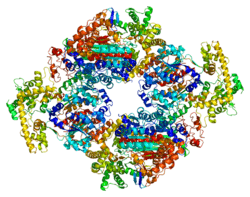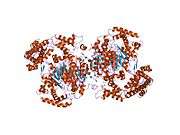APPBP1
NEDD8-activating enzyme E1 regulatory subunit is a protein that in humans is encoded by the NAE1 gene.[3][4][5]
The protein encoded by this gene binds to the beta-amyloid precursor protein. Beta-amyloid precursor protein is a cell surface protein with signal-transducing properties, and it is thought to play a role in the pathogenesis of Alzheimer's disease. In addition, the encoded protein can form a heterodimer with UBE1C and bind and activate NEDD8, a ubiquitin-like protein. This protein is required for cell cycle progression through the S/M checkpoint. Three transcript variants encoding different isoforms have been found for this gene.[5]
Interactions
APPBP1 has been shown to interact with UBE1C,[6] TRIP12[7] and Amyloid precursor protein.[3]
References
Further reading
- Gong L, Yeh ET (1999). "Identification of the activating and conjugating enzymes of the NEDD8 conjugation pathway". J. Biol. Chem. 274 (17): 12036–42. doi:10.1074/jbc.274.17.12036. PMID 10207026.
- Loftus BJ, Kim UJ, Sneddon VP, et al. (1999). "Genome duplications and other features in 12 Mb of DNA sequence from human chromosome 16p and 16q". Genomics. 60 (3): 295–308. doi:10.1006/geno.1999.5927. PMID 10493829.
- Hori T, Osaka F, Chiba T, et al. (2000). "Covalent modification of all members of human cullin family proteins by NEDD8". Oncogene. 18 (48): 6829–34. doi:10.1038/sj.onc.1203093. PMID 10597293.
- Chen Y, McPhie DL, Hirschberg J, Neve RL (2000). "The amyloid precursor protein-binding protein APP-BP1 drives the cell cycle through the S-M checkpoint and causes apoptosis in neurons". J. Biol. Chem. 275 (12): 8929–35. doi:10.1074/jbc.275.12.8929. PMID 10722740.
- Wiemann S, Weil B, Wellenreuther R, et al. (2001). "Toward a Catalog of Human Genes and Proteins: Sequencing and Analysis of 500 Novel Complete Protein Coding Human cDNAs". Genome Res. 11 (3): 422–35. doi:10.1101/gr.GR1547R. PMC 311072
 . PMID 11230166.
. PMID 11230166.
- Strausberg RL, Feingold EA, Grouse LH, et al. (2003). "Generation and initial analysis of more than 15,000 full-length human and mouse cDNA sequences". Proc. Natl. Acad. Sci. U.S.A. 99 (26): 16899–903. doi:10.1073/pnas.242603899. PMC 139241
 . PMID 12477932.
. PMID 12477932.
- Walden H, Podgorski MS, Schulman BA (2003). "Insights into the ubiquitin transfer cascade from the structure of the activating enzyme for NEDD8". Nature. 422 (6929): 330–4. doi:10.1038/nature01456. PMID 12646924.
- Chen Y, Liu W, Naumovski L, Neve RL (2003). "ASPP2 inhibits APP-BP1-mediated NEDD8 conjugation to cullin-1 and decreases APP-BP1-induced cell proliferation and neuronal apoptosis". J. Neurochem. 85 (3): 801–9. doi:10.1046/j.1471-4159.2003.01727.x. PMID 12694406.
- Chen Y, Liu W, McPhie DL, et al. (2003). "APP-BP1 mediates APP-induced apoptosis and DNA synthesis and is increased in Alzheimer's disease brain". J. Cell Biol. 163 (1): 27–33. doi:10.1083/jcb.200304003. PMC 2173435
 . PMID 14557245.
. PMID 14557245.
- Walden H, Podgorski MS, Huang DT, et al. (2004). "The structure of the APPBP1-UBA3-NEDD8-ATP complex reveals the basis for selective ubiquitin-like protein activation by an E1". Mol. Cell. 12 (6): 1427–37. doi:10.1016/S1097-2765(03)00452-0. PMID 14690597.
- Ota T, Suzuki Y, Nishikawa T, et al. (2004). "Complete sequencing and characterization of 21,243 full-length human cDNAs". Nat. Genet. 36 (1): 40–5. doi:10.1038/ng1285. PMID 14702039.
- Huang DT, Miller DW, Mathew R, et al. (2004). "A unique E1–E2 interaction required for optimal conjugation of the ubiquitin-like protein NEDD8". Nat. Struct. Mol. Biol. 11 (10): 927–35. doi:10.1038/nsmb826. PMC 2862556
 . PMID 15361859.
. PMID 15361859.
- Gerhard DS, Wagner L, Feingold EA, et al. (2004). "The Status, Quality, and Expansion of the NIH Full-Length cDNA Project: The Mammalian Gene Collection (MGC)". Genome Res. 14 (10B): 2121–7. doi:10.1101/gr.2596504. PMC 528928
 . PMID 15489334.
. PMID 15489334.
- Rual JF, Venkatesan K, Hao T, et al. (2005). "Towards a proteome-scale map of the human protein-protein interaction network". Nature. 437 (7062): 1173–8. doi:10.1038/nature04209. PMID 16189514.
- Oh JH, Yang JO, Hahn Y, et al. (2006). "Transcriptome analysis of human gastric cancer". Mamm. Genome. 16 (12): 942–54. doi:10.1007/s00335-005-0075-2. PMID 16341674.
- Hiller M, Huse K, Szafranski K, et al. (2007). "Single-Nucleotide Polymorphisms in NAGNAG Acceptors Are Highly Predictive for Variations of Alternative Splicing". Am. J. Hum. Genet. 78 (2): 291–302. doi:10.1086/500151. PMC 1380236
 . PMID 16400609.
. PMID 16400609.
- Norman JA, Shiekhattar R (2006). "Analysis of Nedd8-associated polypeptides: a model for deciphering the pathway for ubiquitin-like modifications". Biochemistry. 45 (9): 3014–9. doi:10.1021/bi052435a. PMID 16503656.
- Li T, Santockyte R, Shen RF, et al. (2006). "A general approach for investigating enzymatic pathways and substrates for ubiquitin-like modifiers". Arch. Biochem. Biophys. 453 (1): 70–4. doi:10.1016/j.abb.2006.03.002. PMID 16620772.
PDB gallery |
|---|
|
| 1r4m: APPBP1-UBA3-NEDD8, an E1-ubiquitin-like protein complex |
| 1r4n: APPBP1-UBA3-NEDD8, an E1-ubiquitin-like protein complex with ATP |
| 1tt5: Structure of APPBP1-UBA3-Ubc12N26: a unique E1-E2 interaction required for optimal conjugation of the ubiquitin-like protein NEDD8 |
| 1yov: Insights into the Ubiquitin Transfer Cascade from the refined structure of the activating enzyme for NEDD8 |
| 2nvu: Structure of APPBP1-UBA3~NEDD8-NEDD8-MgATP-Ubc12(C111A), a trapped ubiquitin-like protein activation complex |
|
|


 . PMID 11230166.
. PMID 11230166. . PMID 12477932.
. PMID 12477932. . PMID 14557245.
. PMID 14557245. . PMID 15361859.
. PMID 15361859. . PMID 15489334.
. PMID 15489334. . PMID 16400609.
. PMID 16400609.



